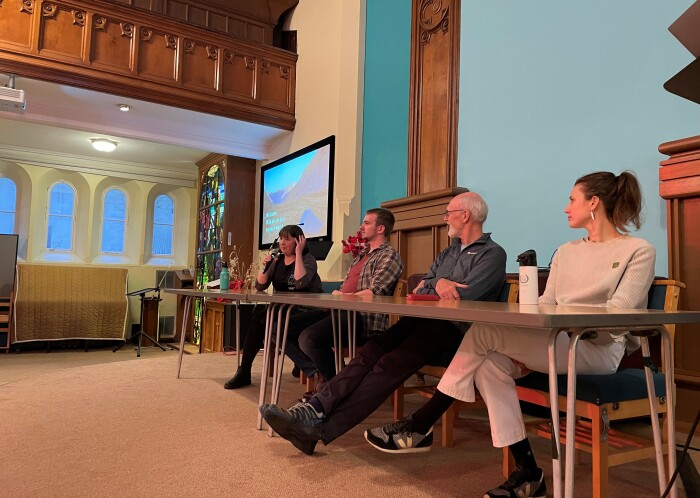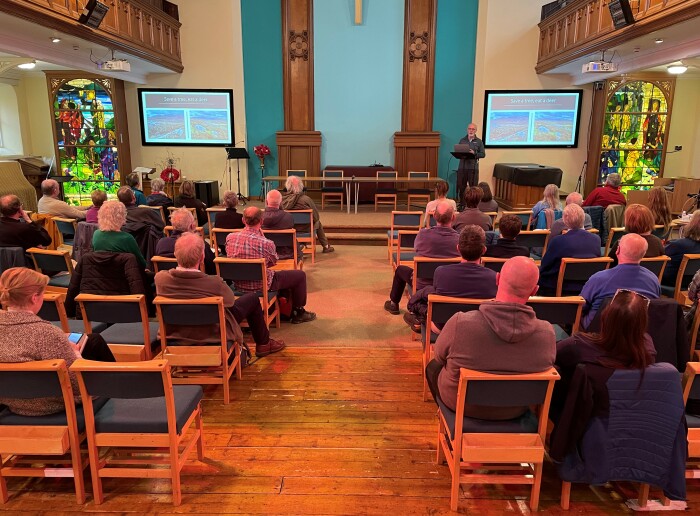Wild places in a warmer world
What does the climate emergency mean for wild places? What role do they have in a warmer world? Our Edinburgh Members' Group asked these questions to a panel of experts at their latest meeting.
Over 30 John Muir Trust Members and guests turned out on a crisp November day to meet in person - the first opportunity since 2019’s last Edinburgh Members’ Gathering - and listen to four speakers relate their work to the event’s theme: ‘wild places in a warmer world’.
The speaker panel comprised Gus Routledge, Director of Reforesting Scotland, Charlotte Maddix from Rewilding Britain, Hillary Sillitto, author of Scotland 2070 and the John Muir Trust’s Wild Places Protection Officer, Fiona Baillie.

Hillary spoke about how a commercially motivated drive to offset carbon in industry and company operations is resulting in swathes of Sitka spruce plantation in Scotland’s wild places. These trees are favoured as they are fast growing ensuring ‘quick returns’ for businesses keen to show they are doing something to offset their emissions. In short, he said, this is, “the story we didn’t want”. Much better would be to have longer-term approaches to Scotland’s timber industry, storing carbon in native trees, harvesting this timber in a more sustainable way – not clear fell all in one go.
Charlotte talked about the value of our choices ahead. We have a choice to make space for nature, so nature can adapt in a warmer climate; for example, by restoring habitats and creating ecological corridors north to south that allow species to migrate and adapt. Both Charlotte and Hillary cited Carrifran Wildwood as a successful exemplar of expanding the space for nature and allowing it to recover, which Charlotte said, has resulted in a “vast ecological corridor for southern Scotland”.

Gus spoke about the importance of people living in, managing and cherishing Scotland’s wild places, recognising that being an ecologist is not enough, and there is a need to understand people, too. He mentioned Loch Arkaig, a community-owned woodland working with the Woodland Trust as an example of local people valuing a wild place, but highlighted that this area under local management for nature is surrounded by vast areas where people have little to no say in the land’s management.
He also took a moderate view on non-native species, such as Sitka spruce plantations, which he has seen can support native wildlife, mosses and capercaillie. He concluded by saying he would like to see these woodlands managed by people living locally, removing timber slowly, allowing nature to co-exist with peoples’ needs.
Fiona used the Trust’s three freedoms - the freedom for nature to repair itself, communities to thrive and people to benefit from wild places - to describe how wild places can provide us with benefits in a warmer world. To help illustrate these benefits, Fiona outlined our plans to develop a wild places register, which later led to conversations during the tea break with Members about their favourite wild places. She also presented on the Trust’s vision for a Just Transition – a prescient issue as we attempt to decarbonise our economy and support fragile rural communities.
After a tea and coffee break, lively discussion followed, with a reminder from Denis Mollison, a founding member of the John Muir Trust, that one of the things the Trust has been able to do successfully is test different approaches to protecting wild places – such as through partnerships, ownership, land management planning – and that, in the context of the upcoming Land Reform Bill, there is value in continuing to take diverse approaches to land management.
Special thanks to Hugh Salvesen and the Trust’s Engagement Officer Ross for coordinating the event. Thanks, too, to Morag at St Augustine’s United Church for the welcome hospitality and to all the Members who attended.

